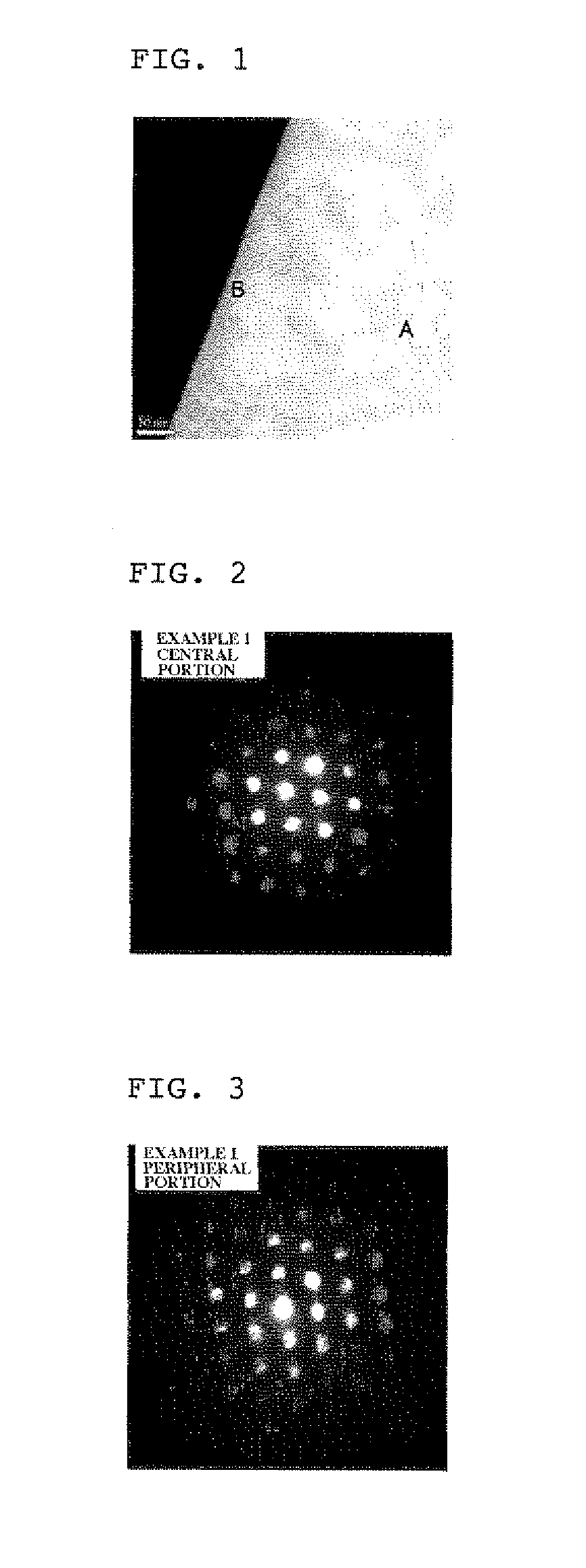Lithium composite compound particles and process for producing the same, and non-aqueous electrolyte secondary battery
a composite compound and lithium composite technology, applied in the direction of nickel compounds, sustainable manufacturing/processing, batteries, etc., can solve the problems of deterioration of battery characteristics, undesirable gelation, and thermal stability degradation, and achieve excellent cycle characteristics and high-temperature storage properties
- Summary
- Abstract
- Description
- Claims
- Application Information
AI Technical Summary
Benefits of technology
Problems solved by technology
Method used
Image
Examples
example 1
[0096]A hydroxide of cobalt, nickel and aluminum was mixed with lithium hydroxide at such a mixing ratio that a molar ratio of Li / (Ni+Co+Al) was 1.08, and the resulting mixture was calcined at 750° C. in an oxygen atmosphere for 20 hr to thereby obtain lithium composite compound particles. The thus obtained lithium composite compound particles were deaggregated, and 60 g of the deaggregated particles were suspended in 300 mL of deionized water maintained at a water temperature of 10° C. The resulting suspension was stirred for 20 min and then subjected to filtration and washing.
[0097]The obtained particles were dried at 120° C. over one night, deaggregated again and then subjected to heat treatment in a decarbonated oxygen atmosphere (CO2 concentration: 20 ppm) at 850° C. for 2 hr.
[0098]The thus obtained lithium composite compound particles were evaluated using a time-of-flight secondary ion mass spectrometer. As a result, it was confirmed that the lithium composite compound particl...
example 2
[0099]The respective raw materials were mixed with each other at such a mixing ratio that a molar ratio of Li / (Ni+Co+Al) was 1.02, and the resulting mixture was subsequently treated in the same manner as defined in Example 1 to thereby obtain particles. The thus obtained particles were washed, dried and then subjected to heat treatment in a decarbonated oxygen atmosphere (CO2 concentration: 20 ppm) at 800° C. for 2 hr.
example 3
[0100]The respective raw materials were mixed with each other at such a mixing ratio that a molar ratio of Li / (Ni+Co+Al) was 1.02, and the resulting mixture was subsequently treated in the same manner as defined in Example 1 to thereby obtain particles. The thus obtained particles were washed, dried and then subjected to heat treatment in a decarbonated air atmosphere (CO2 concentration: 20 ppm) at 800° C. for 2 hr.
PUM
| Property | Measurement | Unit |
|---|---|---|
| average secondary particle diameter | aaaaa | aaaaa |
| specific surface area | aaaaa | aaaaa |
| temperature | aaaaa | aaaaa |
Abstract
Description
Claims
Application Information
 Login to View More
Login to View More - R&D
- Intellectual Property
- Life Sciences
- Materials
- Tech Scout
- Unparalleled Data Quality
- Higher Quality Content
- 60% Fewer Hallucinations
Browse by: Latest US Patents, China's latest patents, Technical Efficacy Thesaurus, Application Domain, Technology Topic, Popular Technical Reports.
© 2025 PatSnap. All rights reserved.Legal|Privacy policy|Modern Slavery Act Transparency Statement|Sitemap|About US| Contact US: help@patsnap.com



